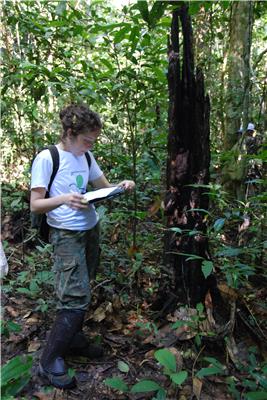Aug 28 2015
Environmental Scientists have developed an affordable technique to help provide evidence of the carbon-saving benefits of tropical forest conservation.
 Photo Credit Jos Barlow : Lead author Erika Berenguer with the field team in a forest recovering from wildfires.
Photo Credit Jos Barlow : Lead author Erika Berenguer with the field team in a forest recovering from wildfires.
Across the tropics, there is a growing financial investment in activities that aim to reduce carbon emissions from deforestation and forest degradation.
However, most tropical countries lack on-the-ground capacity to conduct reliable and replicable assessments of forest carbon stocks, undermining their ability to secure long-term carbon finance for forest conservation programs.
Dr Erika Berenguer, Senior Research Associate at Lancaster University, has put a new technique to the test which aims to find a solution to this problem.
Publishing in the journal Plos One this week (August 26) , an international team of researchers described how rapid assessments of carbon stocks in human-modified tropical forests can be made much cheaper and incur little error by focusing only on measuring trees, but not identifying them to species level – saving up to 74 percent on the financial costs of existing carbon stock measuring techniques.
Dr Berenguer said: “Forest conservation continues to provide a huge opportunity for climate mitigation and the conservation of biodiversity and ecosystem services.
“By providing clear guidance on how to reduce the monetary and time costs of field assessments of forest carbon, we can help tropical countries increase the appeal of carbon-conservation programs to new investors, who are much needed.”
The researchers are also optimistic that the new technique can help make the case for conservation in human-modified tropical forests.
Professor Jos Barlow, a co-author from Lancaster University, said: “This is important as although human-modified forests do not have the same conservation value as undisturbed primary forests, they are the dominant feature of many regions of the humid tropics and, in many places, constitute the last remaining forests.
“The adoption of these cheaper and simple, yet robust, sampling and monitoring protocols provide assurances for investors and project managers that it is possible to accurately assess and monitor changes in carbon stocks in degraded and regenerating forests – thus helping to ensure that this opportunity is not missed.”
The paper ‘Developing cost-effective field assessments of carbon stocks in human-modified tropical forests’ was published in PLOS ONE, 26/8/2015
The authors are: Erika Berenguer, PhD, Toby A. Gardner, Joice Ferreira, Luiz E.O.C. Aragão, Plínio Camargo, Carlos E. Cerri, Mariana Durigan, Raimundo C. Oliveira Junior, Ima C. G. Vieira, Jos Barlow
Source: http://www.lancs.ac.uk/